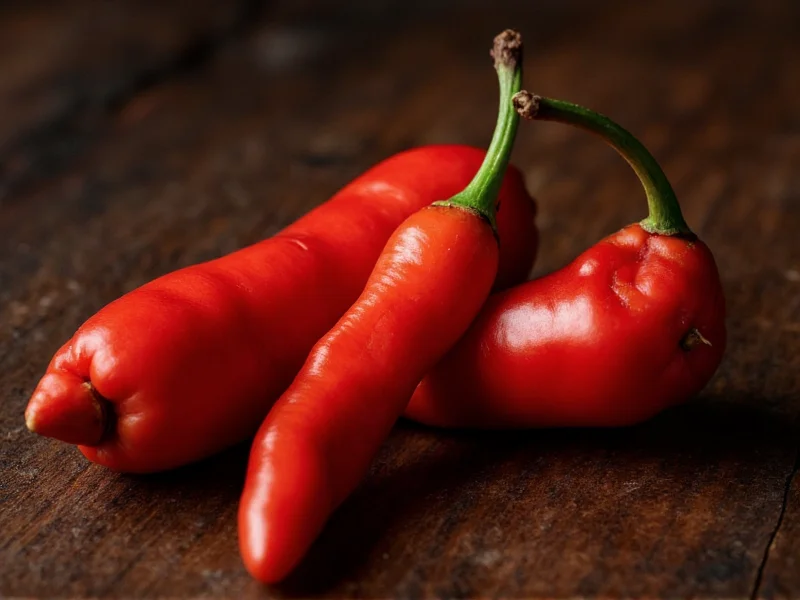The Scoville scale remains the definitive measurement for chili pepper heat, but few peppers command as much respect—and caution—as the ghost chili. Officially certified as the world's hottest chili by Guinness World Records in 2007, this Northeast Indian native delivers a heat experience that demands serious consideration before culinary experimentation.
Understanding the Scoville Scale and Ghost Chili's Place
Developed by pharmacist Wilbur Scoville in 1912, the Scoville scale measures capsaicin concentration—the chemical compound responsible for chili heat. While modern high-performance liquid chromatography (HPLC) provides more precise measurements, Scoville Heat Units remain the standard reference for consumers.
The ghost chili's position on the scale represents a significant threshold. At over 1 million SHU at its peak, it crosses into territory where improper handling can cause serious discomfort. This extreme heat isn't just a number—it translates to a physical experience that begins with intense burning and can progress to sweating, nausea, and temporary loss of sensation.
Ghost Chili: Beyond the Numbers
Bhut jolokia ("Bhut" meaning ghost in Assamese) earned its name from the sensation it creates—heat that seems to sneak up on you unexpectedly. Native to Assam, India, this Capsicum chinense variety features:
- Distinctive red, wrinkled appearance when mature
- Fruity, floral notes beneath the intense heat
- Approximately 2.5-3.5 inches in length
- Used traditionally in Indian cuisine and as a rodent deterrent
Despite losing its "world's hottest" title to newer superhots like the Carolina Reaper, the ghost chili remains a benchmark for extreme heat that continues to challenge even experienced chili enthusiasts.
Ghost Chili Scoville Comparison Chart
| Pepper Variety | Scoville Heat Units (SHU) | Heat Relative to Ghost Chili |
|---|---|---|
| Bell Pepper | 0 | 0× |
| Jalapeño | 2,500-8,000 | 1/100th |
| Serrano | 10,000-23,000 | 1/40th |
| Habanero | 100,000-350,000 | 1/3rd |
| Ghost Chili | 855,000-1,041,427 | 1× |
| Carolina Reaper | 1,400,000-2,200,000 | 1.5-2× |
Practical Implications of Ghost Chili's Heat Level
Understanding ghost chili scoville units isn't just academic—it has real-world consequences. At 1 million SHU, the heat:
- Requires protective gloves during handling to prevent skin irritation
- Demands careful measurement in cooking (a single seed can overwhelm a dish)
- Can cause respiratory discomfort when dried and powdered
- May trigger temporary numbness that affects taste perception
Chefs working with ghost chili typically use specialized techniques like infusing oils rather than direct incorporation. The heat builds gradually, reaching peak intensity after 30-45 seconds, which often catches inexperienced consumers off guard—a phenomenon directly related to its ghost pepper scoville rating characteristics.
Common Misconceptions About Ghost Chili Heat
Several myths persist about ghost chili scoville measurements:
- Myth: All ghost chilies measure exactly 1 million SHU
Reality: Heat varies significantly based on growing conditions, with some specimens falling below 800,000 SHU - Myth: Ghost chili remains the world's hottest pepper
Reality: It was surpassed by the Trinidad Moruga Scorpion and Carolina Reaper, though it remains among the hottest naturally occurring varieties - Myth: Milk completely neutralizes ghost chili heat
Reality: While dairy helps, the extreme capsaicin concentration in ghost chili means relief takes longer and may require multiple applications
Safety Considerations for Ghost Chili Handling
Working with ghost chili scoville levels requires serious precautions:
- Always wear nitrile gloves (latex won't protect against capsaicin)
- Work in well-ventilated areas to avoid airborne capsaicin irritation
- Never touch your face during preparation
- Have dairy products (milk, yogurt) readily available for accidental exposure
- Store prepared ghost chili products clearly labeled with warning indicators
The ghost chili's position on the scoville scale represents more than just a number—it's a threshold where culinary adventure meets serious chemical potency. Respecting this heat level ensures both safety and better culinary results when incorporating this extreme pepper into dishes.











 浙公网安备
33010002000092号
浙公网安备
33010002000092号 浙B2-20120091-4
浙B2-20120091-4